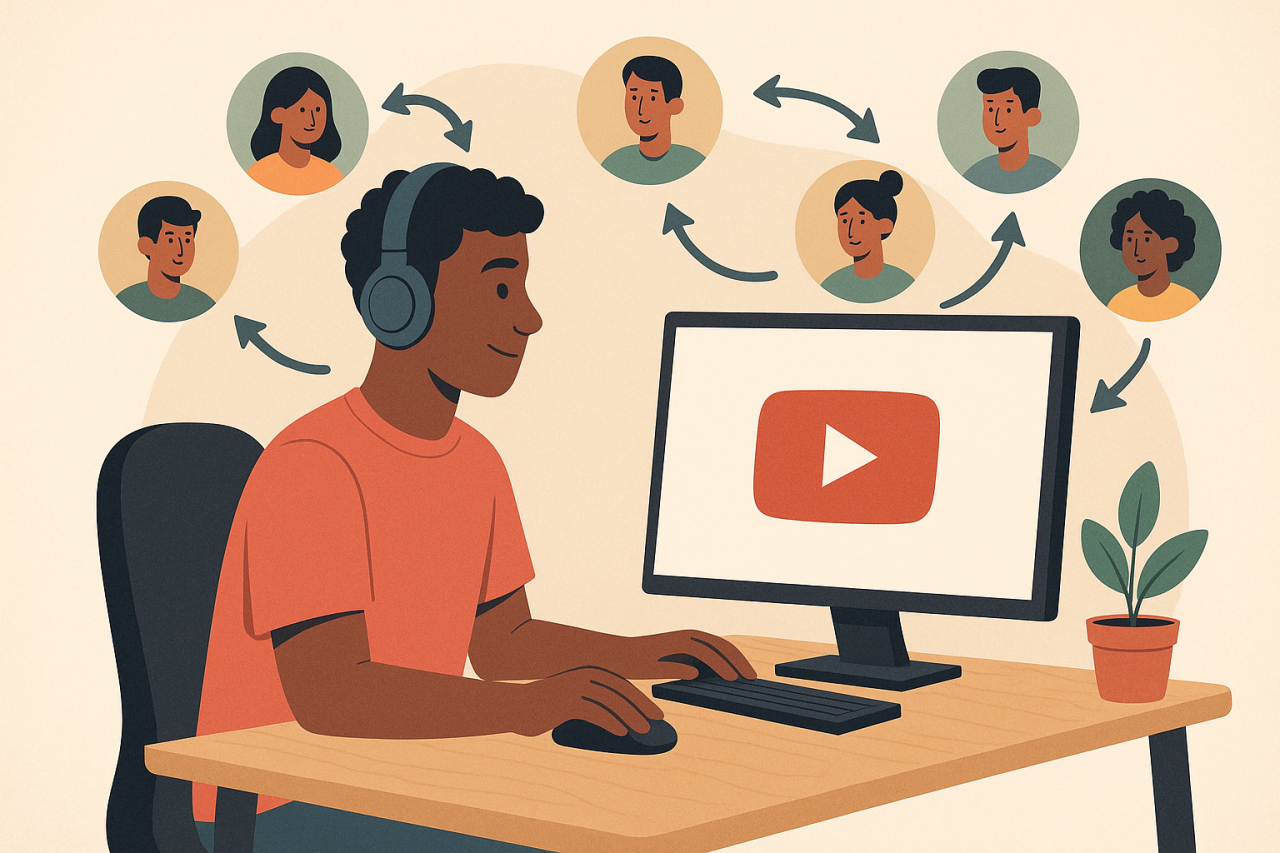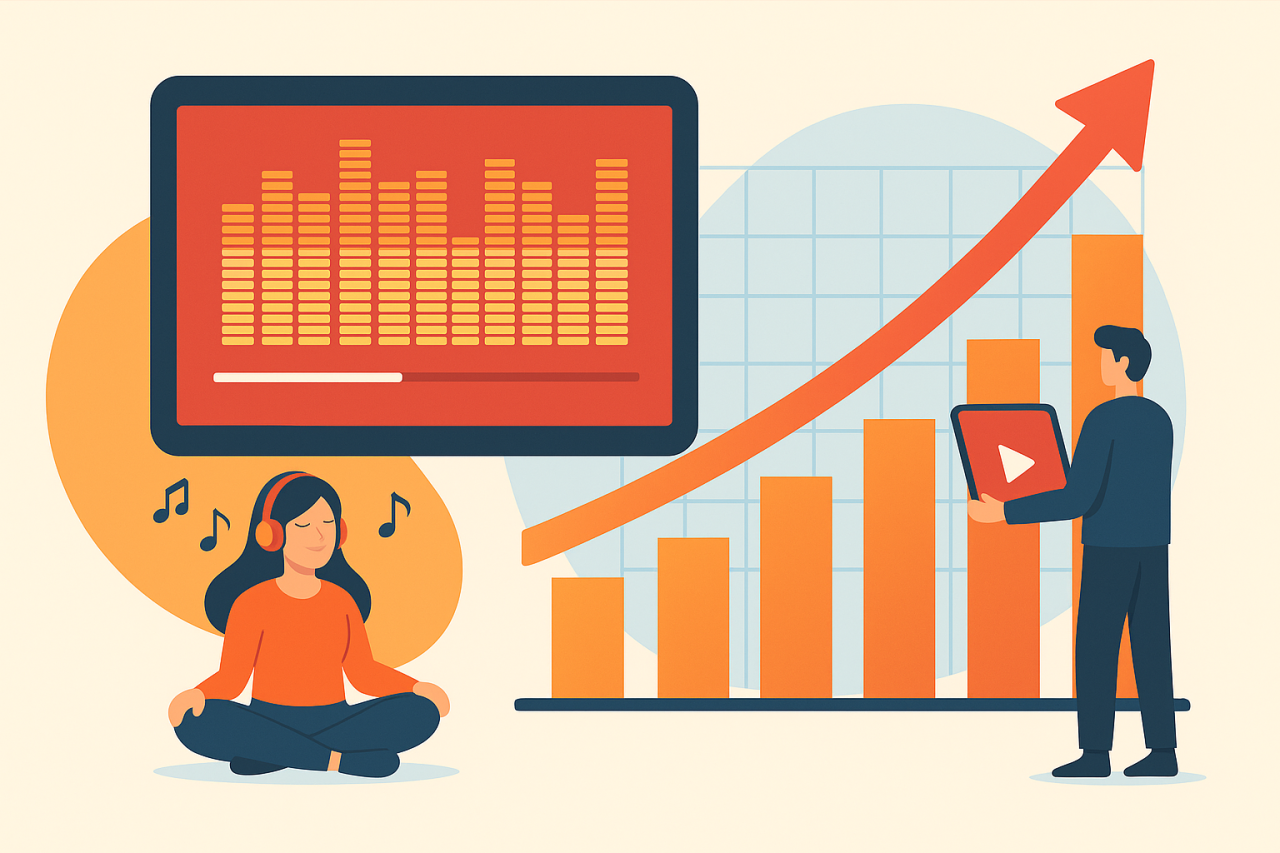Returning viewers – your “regulars” – are people who’ve watched your channel before and come back for more. In 2025, these loyal fans matter more than ever. YouTube’s latest algorithm updates prize channels that feel like destinations rather than one-off stops. Consistent return visitors signal to the system that your content truly resonates. That means more recommendations, longer watch sessions, and even higher ad revenue. A recent media analysis found channels with roughly 20–30% returning viewers grew about three times faster than those with fewer.
May 19 2025 • 14 min read • 2608 words
YouTube Creators: How Many Returning Viewers Do You Have?

What Exactly Are Returning Viewers? W
In YouTube’s analytics lingo, returning viewers are viewers who have watched your channel in the past and then watched again within the selected period. In practice, imagine someone who watched one of your videos two weeks ago and then watches again today – they count as a returning viewer in your stats. YouTube tracks returning vs. new viewers over different windows: you can view the breakdown for the last 7 days, 28 days, or 90 days. Whenever a person who has seen your content in that span watches again, the “returning” counter ticks up (data updates every day or two). Critically, returning doesn’t depend on subscriptions. It’s based on watch history tied to the user’s account or device. Even if someone isn’t subscribed or has unsubscribed, they still register as returning if they keep watching. You’ll see this split in YouTube Studio under the Audience tab as “New vs. Returning viewers.” It tells you if people are coming back for more of your content.
Algorithmically, this metric has big significance in 2025. YouTube’s AI-driven recommendation system treats a steady stream of returning viewers as a green flag. It means your channel content and personality click with people, so the platform is more likely to push your videos to others. With the rise of personalized feeds and session-based ranking, having a built-in audience of repeat watchers is a huge advantage.
Why Returning Viewers Matter
The YouTube algorithm wants viewers to stick around, so it rewards channels that consistently hook fans. Channels with many returning viewers tend to appear more in “Up Next” recommendations and homepage suggestions. In 2025, recommendation AI weighs session goals heavily – a loyal viewer who binges multiple videos on your channel sends a strong signal. In practice, that means a video with 40% returning viewers has a much better chance of getting pushed out to new people than one where only 5% come back for part two. The logic is simple: if people eagerly return, the algorithm figures “this content is worth showing to more people”.
Returning viewers also support monetization more reliably. Steady viewership translates to steady ad revenue, of course – but it goes beyond ads. Engaged fans are the ones most likely to join channel memberships, use Super Chats, buy merch, or follow affiliate links you mention. Think about it: someone who pops in once might click an ad, but a fan who tunes in week after week might invest in your $20 course or Patreon. A higher returning rate typically means your audience trusts your brand enough to support you financially in other ways. In 2025, creators tell us their subscriber count only partly tells the story – a channel could have millions of subscribers but very low returning viewership (most subscribers tuning out). By contrast, a smaller channel with a devoted fanbase of returners often sees better per-view monetization and even attracts sponsorships, because brands value real fan engagement.
When viewers come back, they’re more likely to like, comment, share, and engage in a real dialogue. A one-time visitor might passively watch and disappear, but a loyal viewer often becomes a community member. They’ll chat in comment sections, vote in polls, share videos with friends, and generally boost your social proof. This kind of engagement further pushes your video in rankings (since likes and comments are positive signals) and builds word-of-mouth traction. Importantly, returning viewers often watch more of each video on average than newbies. Analytics show (and creators often observe) that subscribers and repeat visitors have higher average view duration and retention: they watch deeper into the video and are less likely to click away. That directly boosts your overall watch time metric, which is gold for the algorithm.
Returning viewers mean quality views: viewers who care enough to come back. Industry data from early 2025 confirms this. One analytics report noted that channels maintaining around 20–30% returning-viewer rates tend to grow roughly 3× faster than others. Put another way: these channels aren’t just getting lucky with one-hit-wonders; they’re building something lasting. In contrast, channels dominated by one-off views often plateau quickly. Experienced creators know this well: once a solid core audience exists, watch times and CTR (click-through rates) usually climb higher because your fans trust and click your content immediately.
What’s a Good Percentage of Returning Viewers?
A “healthy” returning-viewer percentage varies by niche, but we can sketch some 2025 benchmarks by genre. Keep in mind these are ballpark figures (every channel is unique), but they give a sense of scale.
Typically lower, maybe 10–20% returning viewers, News channels often deal in hot, one-off topics or daily headlines. Many viewers will tune in for a specific story (like a breaking event) and then move on. However, a daily news upload schedule can build a routine core audience: loyal viewers who check your updates every day. Leading news channels report that even if the average returning rate is around a quarter, their top stories might have mostly new eyes while staple segments (like a nightly roundup) draw the habitual crowd. So if your news channel hits around 15% returning viewers, you’re doing well. If it creeps toward 25%, that indicates a surprisingly sticky audience (and might prompt YouTube to push your channel even more strongly as a go-to source).
Usually on the lower side, around 5–15%, especially for general music content. Music videos and audio tracks tend to attract many random listeners for that hit song, but relatively few people will replay or come back video after video (unless you have a dedicated fanbase). However, certain subgenres buck this trend. For example, a composer or band that posts behind-the-scenes or a series of lessons might see higher repeat percentages, say 20–25%. Also, official channels of major artists sometimes have a core fan group that binge-revisits albums. Overall though, if a music channel sees returning viewers climb above 20%, that’s a sign fans are really invested in more than just the top chart hits.
Often 25–40% or more, especially for structured series. Viewers of educational content (tutorials, courses, how-to series) are usually learning, so they tend to consume multiple videos in order. Many creators have noticed their highest returning rates in this niche. For instance, a programming tutorial channel might release a 10-part Python series – someone who watches episode 1 is very likely to watch episodes 2, 3, etc., as long as content quality stays high. In 2025, quite a few e-learning channels boast 30%+ returning. If your educational playlist or course has hundreds of thousands of views, check analytics: you’ll often see a big chunk of those viewers sticking around for part 2 and beyond.
Mixed bag, but often 20–30% is a strong target. In entertainment, we see high returns when content is episodic or personality-driven. A popular gaming streamer who posts a new episode of a series daily might easily hit 30%+ returning viewers, because fans tune in each day. In contrast, a one-off comedy skit channel might see only 10% if people don’t commit to the channel. Entertainment channels can also use seasons: a travel vlogger might split a trip into “Season 1 Episode 1”, building anticipation. Experienced creators usually say that around 25% returning is a nice healthy number – it means a quarter of every batch of viewers is coming back. If you’re in entertainment and running a series or ongoing format, aim for 20–35% returning; outside that, make sure new viewers are also joining to sustain growth.
| Category | Typical Returning Viewer % | Notes |
|---|---|---|
| News | 10–20% | Often topic-driven and short-lived interest. Daily uploads can help build loyal viewers. |
| Music | 5–15% | Mostly one-off plays; higher loyalty for artists, behind-the-scenes, or lesson content. |
| Education | 25–40%+ | High repeat rate due to structured series and bingeable tutorials. |
| Entertainment | 20–30% | Strong if episodic or personality-driven (vlogs, gaming series, travel episodes). |
How Returning Viewers Are Formed
You might wonder how YouTube’s system knows someone is a returning viewer. Behind the scenes, YouTube treats every view as either from a “new” or “returning” viewer based on previous watch history. When a person (logged in or tracked by cookie) watches any video on your channel for the first time in the period, they’re a new viewer. If that same user later watches another video from you within that window, they become a returning viewer. This is automatically handled by the analytics system – creators don’t need to do anything special. What matters is viewer behavior. Returning viewers are formed when you give people reasons to return and an easy way to do so.
User Patterns
Fans who click “subscribe” often end up as returning viewers, but remember, you can have returning viewers who never subscribe. If someone enjoys your videos, YouTube remembers they visited your channel’s videos and will count them when they come back. A common pattern is binge-watching: say someone discovers your channel through one video, enjoys it, and then sticks around to watch another five videos in a row. The second through fifth watches are “returning.” Even more, if they watch one video today and one tomorrow, that’s also returning. So every time they revisit your content, that builds your “returning” count.
Content Behaviors
Serial content and topic consistency help form returning viewers. If you consistently cover the same theme or have the same host, fans know what to expect. For example, consider a weekly mini-series on tech news. Each installment ends with a hint about next week’s topic. Viewers who cared about this week’s tech news will likely come back next week because they know you’ll cover a related story. That’s exactly how series create returning viewers: each part of the series prompts the same people to return. It’s similar for channels with a strong brand voice or format – familiarity makes viewers comfortable enough to come back. The YouTube Help Center notes exactly this: channels with consistent topics, formats, or familiar hosts tend to have more stable, returning viewership.
Playlists & Binge Incentives
If you organize videos into a playlist, returning viewers naturally form. A playlist auto-plays the next video, which often keeps a viewer watching multiple pieces. Later, when they come back, they might start the playlist again or pick up where they left off. This means playlists turn one-time visitors into repeat visitors over days or weeks. Another behavior: users often explore older videos if they enjoyed one. If your video mentions “remember to check out Part 1 in the series”, that can spur someone to go watch it – making them a returning viewer if that happens in the same analytics window.
Community Interaction
Sometimes returning viewers are literally followers of your activity. If you ask a question in comments or on a poll, people may come back to see the outcome. A viewer who comments on a video or participates in a poll can become a returning viewer in subsequent sessions just out of curiosity for results or answers. Engagement breeds return visits.
Importantly, returning viewers aren’t limited to your subscriber list. It’s common for non-subscribers to watch multiple videos if they find one that piques their interest. In fact, YouTube’s data shows channels often have fewer returning viewers than subscribers – because not everyone who subscribes keeps watching every video. So a channel might have 100,000 subscribers but only 3,000 returning viewers in the last month. Building returning viewership is about turning casual fans into fans who actively choose to engage regularly.
How to Boost Returning Viewers
Now for the heart of the matter: how do you actually increase your returning viewer count?
Stick to a predictable schedule. When your audience knows exactly when to expect new videos, they’ll set their calendars or subscriptions notifications accordingly. For example, a tech review channel might always post every Tuesday and Friday at 10am. Over a few months, fans get into the habit of checking in on Tuesday mornings. Many creators find that missing a scheduled date causes a drop in immediate returns. In 2025, analytics firms report that channels with regular schedules see their returning rates climb steadily. A concrete example: one cooking channel increased returning traffic by nearly 15% by moving to a “Monday and Thursday” release pattern, so viewers knew to come back on those days. In short, be consistent – it signals reliability, and viewers respond by clicking back on your next post.
Give your content a narrative or series feel. Plan multi-part videos, sequels, or chaptered playlists. For instance, if you do travel vlogs, break a trip into parts (Day 1, Day 2, etc.) instead of one long video. At the end of each, tease the next part (“Next time, we explore the local market!”). Similarly, storytellers or educators can label videos as “Episode 1, 2, 3” to subconsciously tell viewers “there’s more to come.” This builds anticipation. It’s a bit like TV series: viewers return to see the next episode. A concrete example: a gaming channel started adding “To be continued…” at the end of their videos, and saw their playlist retention jump. It worked because viewers were curious to see “what happens next”. Continuity also includes callbacks. Mentioning the last video’s highlights or a running joke (“if you remember from Part 1…”) nudges fans to rewatch or check that video too, effectively making them return to your own channel to catch up.
Your thumbnails and titles aren’t just for new clicks – they help returning viewers spot you in a crowded feed. Use consistent colors, fonts, and layout style so your audience can instantly recognize “Oh, that’s from [YourChannel]!” even before clicking. Think of it like episode covers – TV shows use a similar visual style for each episode’s art. If a returning fan scrolls through YouTube and sees your familiar thumbnail border or logo, they’re more likely to click. For example, a fitness channel uses the same bold text font and a small version of their logo on every thumbnail. Viewers started calling that style the channel’s “signature look.” Meanwhile, in titles, consider using series names or episode numbers (“Ep. 5: How to Bake Bread”). This continuity helps both new and returning fans know where they are. Marketing studies suggest that consistent thumbnail branding can improve overall click-through by up to 10% – a boost that mostly comes from viewers who already trust your brand. Over time, this small lift means more repeated sessions just because people recognize and favor your content.
Collectively, these strategies all boil down to two things: habit-building and value delivery. You want viewers to expect and get something from you every time they visit. Data from 2025 supports each of these tips. For example, one analysis found that channels that used frequent community tab polls and consistent titles saw a 25% higher returning rate than the average channel of their size. Another channel case study reported that splitting videos into a 3-part series (with trailers linking each) doubled the playlist completion rate and increased the week-over-week returning viewer percentage by 20%. These are impressive gains considering they came from organic methods (no paid ads or giveaways).
Remember, what experience creators often mention is the “snowball effect.” Early on, every returning viewer is a small seed – but as they watch more, they share and interact more, leading to slightly more new viewers, some of whom become returners, etc. Over months, a positive loop forms. Review your analytics: which videos had the highest returning/viewer ratio? That’s a clue to what your audience loves. Double down on that format.
You might like

Video Length and YouTube Algorithm: Strategies for Music Channels in 2025
May 03 2025
YouTube’s Algorithm In 2025: A Creator’s Guide to Discovery and Growth
May 04 2025
How YouTube Playlists Boost Music Channel Performance
May 04 2025
YouTube Video Content vs. AI Realism: Why Creator Survival Won’t Be Easy
May 30 2025